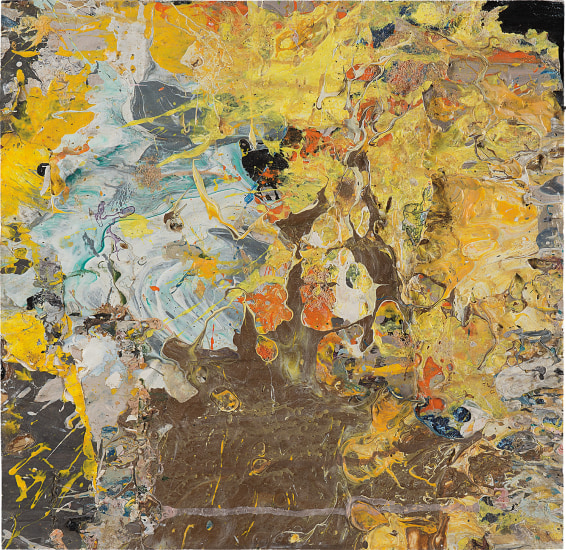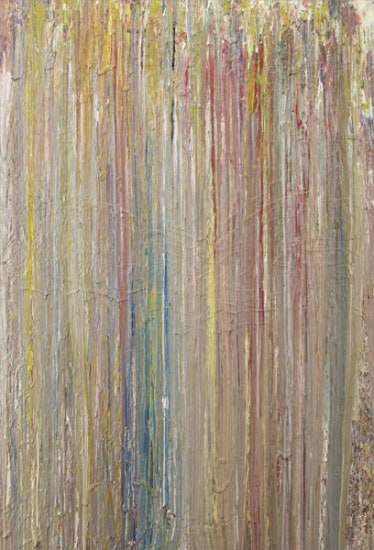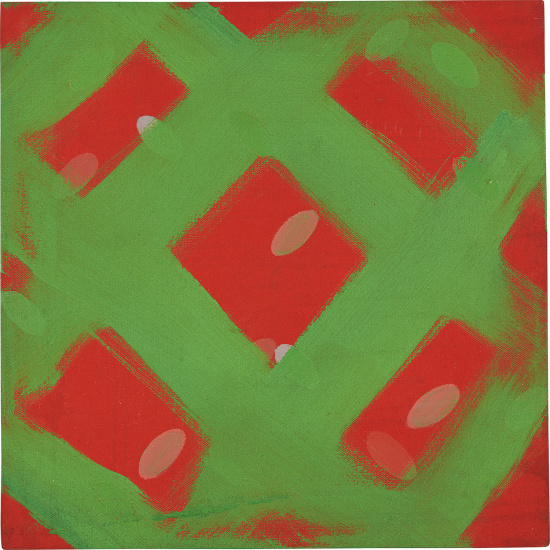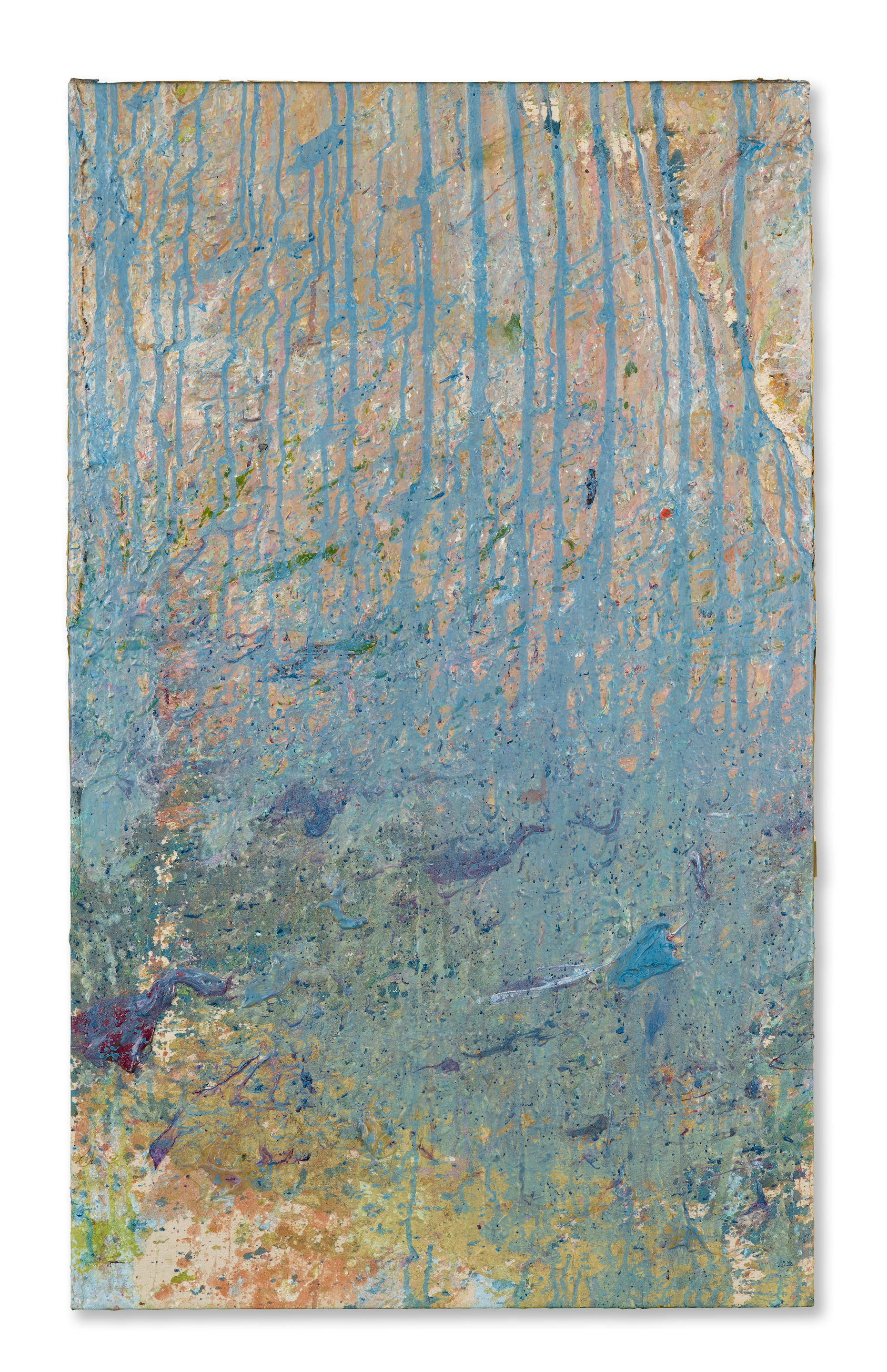Larry Poons Jessica's Hartford 1965 acrylic on canvas 128 1/4 x 80 in. (325.8 x 203.2 cm) Signed and dated "1965 L. Poons" on the reverse. This work has both a vertical and horizontal orientation.
Provenance Mr. & Mrs. Robert B. Mayer, Chicago Sotheby’s, New York, Contemporary Art, Part II, November 9, 1989, lot 335 Leo Castelli Gallery, New York Sotheby’s, New York, Contemporary Art, Part II, May 3, 1995, lot 169 PaceWildenstein, New York Private Collection, New York Exhibited Washington, D.C., Corcoran Gallery of Art, 30th Biennial Exhibition of Contemporary American Painting, February 24 – April 19, 1967 New York, Jacobson Howard Gallery, Classic Works from the 1960s, December 3, 2003 – January 26, 2004 New York, Loretta Howard Gallery, Larry Poons Geometry and Dots, November 7 – December 14, 2013 Catalogue Essay “The important thing is the interrelationship between all the colors. And whatever that relationship might end up being is the way the painting is going to look.” Larry Poons 1965 In 1963, at only 26 years of age, Larry Poons was given his first solo exhibition at Green Gallery. He quickly rose to prominence in the New York art world shortly thereafter when his work was featured in “The Responsive Eye,” The Museum of Modern Art’s celebrated exhibition from 1965 that sought to shed light on new methods of optical representation. Four years later, Poons would be included in Henry Geldzahler’s landmark survey exhibition at the Metropolitan Museum of Art. “New York Painting and Sculpture: 1940-1970” was comprised of 43 artists spanning two and a half generations, including Robert Motherwell Frank Stella and Helen Frankenthaler; the 33 year-old Poons was the youngest participant. The works for which Poons was being acknowledged during these formative years were known as the Dot paintings: large-scale paintings of solid circles and ovals juxtaposed against intense, monochromatic backgrounds. The contrasting relationship between the vast color fields that occupy the majority of the canvas and the complementary colors of the interspersed ellipses creates a destabilizing, flickering effect. The irregular and seemingly random arrangement of the ellipses enhances the optical impact of the painting, denying the viewer’s eyes the opportunity to rest. Jessica’s Hartford, painted in 1965, is the epitome of this celebrated early series by Larry Poons Vivid orange, lime green and white ovals glitter across the entire canvas, which is painted in a striking chartreuse tint. The haphazard patterning of the dots creates the illusion of space that repeatedly fools the eye. There is a structure, to be sure, but one cannot quite grasp where its logic lies. The painting suggests a rationale the viewer can expect to follow, only to then abandon it and disrupt any notion of an orderly composition. There is an unresolved playfulness in the work that both delights and frustrates. This visual complexity is precisely what the influencers of the time were responding to in their praise of the series. Early critical reception of these works tied Poons to a variety of movements, most notably Op Art, as well as Color Field painting and Minimalism. Poons sought to distance himself from the artists of the Op Art movement, such as Bridget Riley and Victor Vasarely stating that the optical effects of his works were simply unintended consequences. Rather, he wished to align himself more with painterly abstraction, particularly that of geometric abstraction as exemplified by Piet Mondrian Poons was heavily influenced by experiments with color and composition as they related to music and was interested in a further exploration of Mondrian’s rhythmic abstraction and use of primordial color. This combined with his musical training and background would largely inform his early work. Poons studied composition at the New England Conservatory of Music from 1955-57. Upon moving to New York, he connected with artists that would go on to form part of Fluxus and later enrolled in one of John Cage’s courses at the New School, whose immensely influential teachings emphasized the notated score and chance operations as a starting point for artistic creation.
Larry Poons Jessica's Hartford 1965 acrylic on canvas 128 1/4 x 80 in. (325.8 x 203.2 cm) Signed and dated "1965 L. Poons" on the reverse. This work has both a vertical and horizontal orientation.
Provenance Mr. & Mrs. Robert B. Mayer, Chicago Sotheby’s, New York, Contemporary Art, Part II, November 9, 1989, lot 335 Leo Castelli Gallery, New York Sotheby’s, New York, Contemporary Art, Part II, May 3, 1995, lot 169 PaceWildenstein, New York Private Collection, New York Exhibited Washington, D.C., Corcoran Gallery of Art, 30th Biennial Exhibition of Contemporary American Painting, February 24 – April 19, 1967 New York, Jacobson Howard Gallery, Classic Works from the 1960s, December 3, 2003 – January 26, 2004 New York, Loretta Howard Gallery, Larry Poons Geometry and Dots, November 7 – December 14, 2013 Catalogue Essay “The important thing is the interrelationship between all the colors. And whatever that relationship might end up being is the way the painting is going to look.” Larry Poons 1965 In 1963, at only 26 years of age, Larry Poons was given his first solo exhibition at Green Gallery. He quickly rose to prominence in the New York art world shortly thereafter when his work was featured in “The Responsive Eye,” The Museum of Modern Art’s celebrated exhibition from 1965 that sought to shed light on new methods of optical representation. Four years later, Poons would be included in Henry Geldzahler’s landmark survey exhibition at the Metropolitan Museum of Art. “New York Painting and Sculpture: 1940-1970” was comprised of 43 artists spanning two and a half generations, including Robert Motherwell Frank Stella and Helen Frankenthaler; the 33 year-old Poons was the youngest participant. The works for which Poons was being acknowledged during these formative years were known as the Dot paintings: large-scale paintings of solid circles and ovals juxtaposed against intense, monochromatic backgrounds. The contrasting relationship between the vast color fields that occupy the majority of the canvas and the complementary colors of the interspersed ellipses creates a destabilizing, flickering effect. The irregular and seemingly random arrangement of the ellipses enhances the optical impact of the painting, denying the viewer’s eyes the opportunity to rest. Jessica’s Hartford, painted in 1965, is the epitome of this celebrated early series by Larry Poons Vivid orange, lime green and white ovals glitter across the entire canvas, which is painted in a striking chartreuse tint. The haphazard patterning of the dots creates the illusion of space that repeatedly fools the eye. There is a structure, to be sure, but one cannot quite grasp where its logic lies. The painting suggests a rationale the viewer can expect to follow, only to then abandon it and disrupt any notion of an orderly composition. There is an unresolved playfulness in the work that both delights and frustrates. This visual complexity is precisely what the influencers of the time were responding to in their praise of the series. Early critical reception of these works tied Poons to a variety of movements, most notably Op Art, as well as Color Field painting and Minimalism. Poons sought to distance himself from the artists of the Op Art movement, such as Bridget Riley and Victor Vasarely stating that the optical effects of his works were simply unintended consequences. Rather, he wished to align himself more with painterly abstraction, particularly that of geometric abstraction as exemplified by Piet Mondrian Poons was heavily influenced by experiments with color and composition as they related to music and was interested in a further exploration of Mondrian’s rhythmic abstraction and use of primordial color. This combined with his musical training and background would largely inform his early work. Poons studied composition at the New England Conservatory of Music from 1955-57. Upon moving to New York, he connected with artists that would go on to form part of Fluxus and later enrolled in one of John Cage’s courses at the New School, whose immensely influential teachings emphasized the notated score and chance operations as a starting point for artistic creation.








.jpg)
.jpg)



.jpg)
.jpg)
Try LotSearch and its premium features for 7 days - without any costs!
Be notified automatically about new items in upcoming auctions.
Create an alert